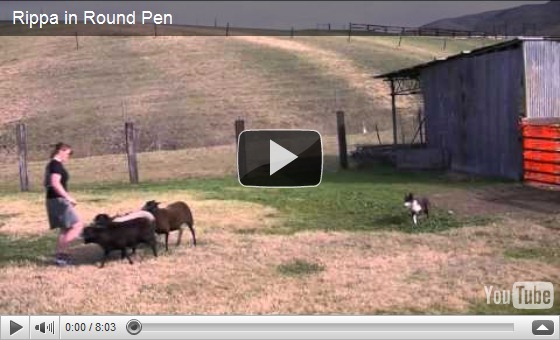So no videos for this week’s lesson (I do need to look at the other week’s and get that up), but let’s do a little summation of puppy-issues.
Well, one, Rippa bear is much different to work than Fury. She definitely gives me more time to think, but she takes Fury’s stubborn streak into the duck pen with her. Fury, in agility, will run fast and hard, but if I make a mistake, she is like, “Nah, I do it right, or not at all.”
Now, Fury is crisp when she works. Very precise with her body and her movements, and so I am not surprised by her shutting down if I make a mistake that throws off her flow.
But Rippa is a clod. She paws your face, slumps over in whatever position’s available, and is generally not so body sensitive. The other night, Yishai was motioning her to get into his lap and she jumped up and she basically punched herself in the face with his fist accidentally. He was like, “I am SO SORRY!” And she could have cared less.
But when Rippa works the sheep right now, if it isn’t going the way she wants it to, she checks out. Not like uninterested, sniffy, spacy, just kind of turns off. She downs really nice for me in the pen.
Kathy seems to think this has to do with our relationship. She prescribes no obedience drills (“use bait” for training) and just being nicer to her. I AM nice to her. As I type this, she is asleep on my left arm. She keeps saying perhaps she’ll work nicer for Yishai as she’s his dog. Given that Yishai and I, while not married yet, are attached at the hip, she’s very much even steven on whose dog she is. He’s nicer to her, yes (he’s just generally sweeter than me in general), but he also doesn’t get the respect she affords me because I handle her better.
Anyway, what I honestly think it is, is that what’s going on with the Fury is what’s going on with the Rippa. She’s not totally sure what she’s doing is right, so if I put too much pressure on her, she goes, “Okay then, YOU do it” and lays down. I am teaching Rippy to call off of the sheep and come to me and even getting her up to follow me, she sort of cringes. I honestly think it looks like she’s scared to be wrong.
Which is funny, because I don’t see Rippa as worried about ANYTHING. More time will tell.
So what did we do to counter this? The first session (Kathy does two sessions with you, not longer than twenty minutes each), we saw her shutting down and wondered what to do. Kathy took the wheel and Rippa worked a little better, stopped running and wearing as much, but she still faded out and came over to me, and tried to get over to Yishai and Fury. So we called it quits after I had her do an outrun and then a fetch and let her have a break.
So I played with her and then we were back in.
So here’s what I did. We got in there, and I kind of squatted, walking backwards (and HOOO boy, was that a workout) to hold the sheep and keep them balanced on me (they are very heavy and have no problem making me their flock) and then watched Rippa and wherever Rippa was trying to go, I helped her by going opposite that so Rippa go her way. Usually, you drive and the dog follows, but our roles were reversed. I watched what she did and moved where I should be to make that happen. It was pretty interesting to do. It kept Rippa engaged enough that when she got too tight and I pushed her out, she wouldn’t get mad.
Problem with this is that I am crap-tastic about planning for hitting the fence and we’d only get twenty feet before I’d hit a fence, so I think next time we go, it’s time for the arena (normal trialing arena). She’s in enough control it won’t be a disaster but Kathy was quick to tell me we were doing that for me, not Rippa, so I could work on handling her without mucking it up every time. So that should be interesting.
The other thing I am really not used to, is that when Rippa does outruns between me and the sheep, she’ll pick a side but not follow through with it – so at the last minute, she changes directions and then it looks bad because I don’t have the wherewithal to follow through. Kathy says to just learn to be ready for it – she sees the head turn and acts accordingly, nothing wrong with that . . . and I’m not asking her for flanks yet, we’re literally just teaching her to GET OUT. We kind of want her on lighter sheep now, but she needs to get OUT. So . . . that’s where we’re at.
Yishai and I were kind of downtrodden about Rippa shutting down like that. Kathy reminded me that Fury was so much sharper, nothing stops her. But as she followed us out of the working area with her dog, Deni, she said, “Hey, Deni was a dog like that – she could have shut down if not managed right. She wanted to work a certain way – close – still does.” So, while I’ve been feeling like I have the world’s perfect dog, it’s a little bummer to see a setback, but we’ll work through it.
But I am NOT mean to Rippa!
